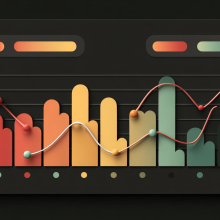Affiliate Marketing Trends in 2025: What You Need to Know to Stay Ahead

As affiliate marketing enters a new era, it’s clear that the landscape in 2025 is vastly different from even just a couple of years ago. What once worked – static product reviews, banner ads, and blogroll links – simply doesn’t cut it anymore.
Today’s affiliate marketers are navigating a space shaped by artificial intelligence, evolving consumer habits, stricter compliance rules, and content platforms that reward video-first storytelling. Whether you’re a seasoned affiliate or just testing the waters, staying ahead of the curve is no longer optional; it’s essential.
This article explores the most important trends shaping affiliate marketing in 2025, offering a blueprint to not just survive, but to thrive, in this fast-changing digital ecosystem.
Artificial intelligence is redefining the affiliate workflow
AI isn’t just a buzzword anymore; it’s embedded in nearly every aspect of modern affiliate marketing. From writing content to generating images, enhancing SEO, automating funnels, and analyzing user behavior, machine learning tools have become indispensable.
Many affiliates are now using tools like Jasper, ChatGPT, Copy.ai, or Surfer SEO to produce optimized blog posts, landing pages, and even email sequences at scale. AI also assists with audience targeting and content planning based on data rather than intuition.
What this means for affiliates is simple: those who incorporate AI strategically gain a significant edge in both productivity and performance.
Takeaway: Embrace AI not as a replacement for creativity, but as an amplifier of it. Automate what you can, so you can focus on building relationships, creating trust, and promoting the right offers.
Micro-niches are overtaking broad categories
The affiliate space has matured, and so has consumer awareness. Gone are the days when you could create a generic “Best Fitness Gear” blog and dominate search rankings. In 2025, niche depth matters more than niche size.
Successful affiliates are now narrowing their focus to highly specific sub-audiences – think keto meal plans for postpartum moms, ergonomic desk tools for remote software developers, or grooming products for senior dogs.
This laser focus not only allows affiliates to better match products to consumer needs but also enhances trust and authority in a given space.
Why this works:
- It’s easier to rank for long-tail keywords
- Conversion rates are significantly higher
- Competition is thinner in sub-niches
- Content can be more personalized and relatable
Tip: Use forums, Reddit threads, niche Facebook groups, or keyword tools like Ahrefs and AnswerThePublic to uncover hidden gaps in the market.
Video-first affiliate strategies are exploding
If you’re still thinking of affiliate marketing as a written blog game, you’re missing where the consumer attention actually is: short-form video. In 2025, TikTok, YouTube Shorts, and Instagram Reels are some of the most powerful discovery engines for affiliate offers.
Creators are leveraging these platforms to produce authentic, “unpolished” content – product demos, reaction videos, personal stories – that naturally blend in their affiliate links. These aren’t traditional ads. They’re bite-sized pieces of social proof, often shot from a smartphone in under 60 seconds.
More importantly, audiences engage with this type of content, and platforms reward it with visibility.
What to do:
- Test quick product tip videos
- Share use cases from your own life
- Offer honest, casual reviews
- Include trackable links in bios, link hubs, or video descriptions
If you’re camera-shy, there are plenty of tools now available to create faceless content with voiceovers or text overlays.
Influencer marketing and affiliate marketing are blending
In 2025, the line between “influencer” and “affiliate” has nearly disappeared. Influencers are increasingly paid by performance – not just for reach – and affiliates are acting more like content creators than ever before.
Brands are becoming more selective, choosing to partner with individuals who not only have followers but can drive measurable conversions through trust-based content. This has created a surge in hybrid affiliate-influencer roles.
For affiliate marketers, this presents a big opportunity: if you’ve built even a modest audience that trusts you, you can position yourself as both an affiliate and a micro-influencer.
Ideas to explore:
- Offer affiliate-friendly discount codes for your audience
- Co-create content with other creators in your niche
- Reach out to affiliate managers and propose collaboration campaigns
- Use testimonials and story-driven content to connect emotionally
Authenticity continues to be the currency of trust, and trust converts.
Google is prioritizing authority, not just keywords
The Google algorithm in 2025 is much more sophisticated than it was just a few years ago. It’s no longer enough to stuff a page with keywords and hope for rankings.
The focus now is on authority – and specifically the E-E-A-T framework: Experience, Expertise, Authoritativeness, and Trustworthiness.
Search engines are looking for content that demonstrates real, lived experience with the products being discussed. They favor creators who can back up their recommendations with proof, whether that’s through original images, testimonials, author credentials, or user data.
What to do:
- Add personal commentary and results to every product you recommend
- Include author bios that show your qualifications or experience
- Use structured data and schema markup to help search engines understand your content
- Link out to authoritative sources to support claims
In short, focus on being helpful and honest, not just optimized.
Performance-based tiering is becoming the norm
More affiliate programs are now implementing performance-based tiers, where commission rates are determined by your results over time. Affiliates who consistently drive traffic, conversions, or customer retention are rewarded with better terms, higher percentages, and even exclusive perks.
This shift means it’s not enough to simply “get in” to a program – you have to stay competitive to keep earning at the top.
Some programs even use dynamic commissions that increase based on total revenue brought in over a set period, or reward rebills for subscription-based products.
Tip: Always check if your program offers tiered rates, and don’t be afraid to reach out to affiliate managers to negotiate if you’re sending consistent traffic.
Building relationships with your affiliate partners is now a strategic move, not just a courtesy.
Regulation and compliance are tightening
Increased scrutiny from regulators like the FTC, GDPR, and other international bodies means that affiliate marketing in 2025 is more legally bound than ever before.
Affiliates must now:
- Disclose partnerships clearly and early in every piece of content
- Obtain proper cookie consent and user tracking permissions
- Avoid deceptive or exaggerated claims
- Follow guidelines for email opt-ins and user data handling
Failing to do so isn’t just a slap on the wrist – it can get your affiliate account terminated or even land you in legal trouble.
To stay safe, it’s essential to:
- Use disclosure templates that are clear, honest, and placed before any affiliate links
- Utilize consent management platforms like Termly, Cookiebot, or iubenda
- Ensure that your website contains an accurate privacy policy to disclose how you collect and use data from your visitors.
- Review each affiliate program’s terms of service – some now require disclosures in very specific formats
Global markets are gaining ground
As internet accessibility and e-commerce infrastructure improve globally, affiliate marketers are beginning to look beyond the U.S., U.K., and Canadian markets.
Regions like Southeast Asia, Eastern Europe, Latin America, and the Middle East are showing explosive growth in online purchasing behavior – and yet remain largely untapped by Western affiliates.
What makes this opportunity compelling:
- Less saturation
- Diverse product demand
- Affiliate networks tailored to local platforms (e.g., Flipkart in India, Shopee in Asia, Jumia in Africa)
Localizing content for new regions – either through translation or region-specific offers – is a growing trend. Just make sure to research cultural relevance and platform preferences.
Tip: Use tools like SimilarWeb or Statista to analyze regional web behavior before diving in.
Recurring revenue is replacing one-time commissions
Subscription-based affiliate programs, like SaaS tools, subscription boxes, or membership communities, are becoming increasingly attractive. They offer affiliates a key benefit: recurring monthly commissions instead of a single payout.
By promoting tools or services that provide ongoing value to customers, you build long-term income streams that snowball with time.
This is especially effective in niches like:
- Software and productivity tools
- Health and wellness (supplement subscriptions, coaching platforms)
- Digital education (course platforms, newsletters, memberships)
Many of these programs now offer 20-40% recurring commissions, making them far more sustainable than product-focused models with one-time payments.
If you haven’t yet built a portfolio of recurring programs, 2025 is the year to start.
Centralized affiliate toolkits are on the rise
Affiliate marketers used to juggle dozens of disconnected tools: one for email, another for funnel building, yet another for link tracking or analytics. But that model is fading.
Today, centralized platforms that combine these features into one dashboard are becoming the preferred solution – especially for solo creators or small teams.
Tools like:
- Systeme.io
- Kartra
- ClickFunnels 2.0
- Groove.cm
are increasingly favored for their simplicity and integrated systems. They reduce costs, simplify tracking, and often include built-in affiliate management if you’re running your own program.
Better yet, most of them offer affiliate programs themselves, making them a revenue opportunity as well.
Data and analytics are central to decision-making
In 2025, flying blind is no longer acceptable. Top affiliates are leaning heavily into analytics to understand what’s working, what isn’t, and where to focus next.
This includes:
- Tracking link click-through rates and conversion paths
- A/B testing landing page designs and call-to-actions
- Monitoring heatmaps to study user behavior
- Measuring lifetime value per customer acquisition channel
If you’re not analyzing, you’re guessing—and that’s expensive.
Some of the best tools to consider:
- AnyTrack (multi-network link tracking)
- Fathom (privacy-focused analytics)
- Matomo (GDPR-compliant Google Analytics alternative)
- Hotjar (user session replays and heatmaps)
A good rule of thumb: If you can’t measure it, you can’t improve it.
Adaptation is the new superpower
Affiliate marketing in 2025 is more dynamic, more competitive, and more rewarding than ever before. But it’s also more demanding. To stay relevant and profitable, you need to be more than just a promoter – you need to be a strategist, a content creator, and a trustworthy voice in your niche.
Trends come and go, but the core principles remain:
- Build relationships before you pitch
- Focus on solving real problems for real people
- Test, measure, and iterate constantly
- Keep learning, because the rules will keep evolving
If you’re prepared to stay flexible, lean into new platforms, and treat affiliate marketing like a real business (not a shortcut), then 2025 could be your breakout year.
Next step? Choose one trend from this article and implement it this week. Don’t try to do everything at once. Small, focused adjustments lead to compounding results over time.
Let’s make 2025 your most profitable year yet.



